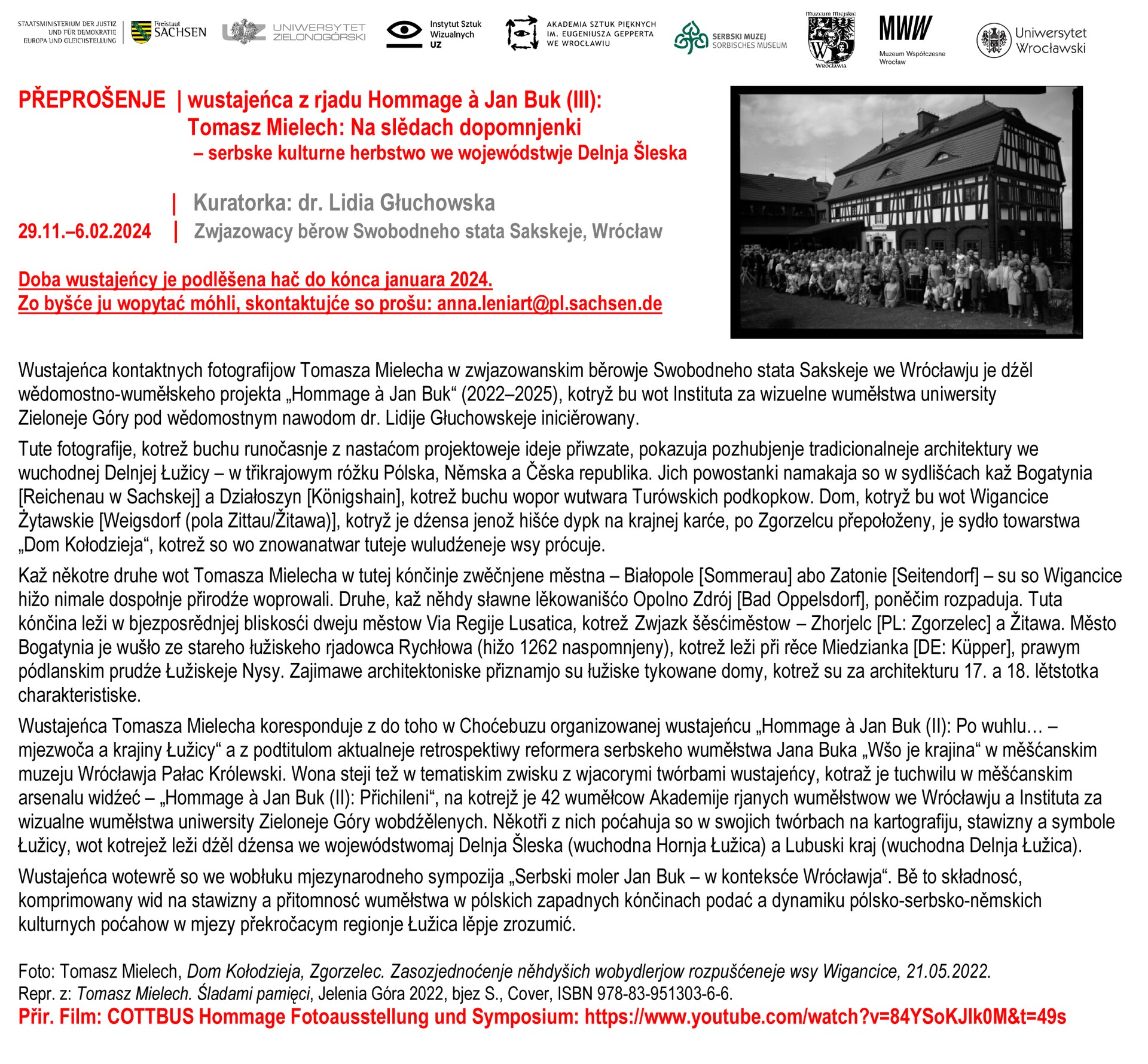Zmień rozmiar czcionki
Wersje kontrastowe
Język
en
Do 6.02.2024 r. przedłużona została wystawa fotograficzna realizowana w ramach tego samego projektu „Hommage à Jan Buck (III): Tomasz Mielech: Śladami pamięci – serbołużycka spuścizna kulturalna na Dolnym Śląsku” prezentowana we wrocławskim Biurze Saksonii. Pisaliśmy już o niej na stronach naszego Instytutu.
Obecnie załączamy także teksty o niej w językach górno- i dolnołżyckim.
Tomasz Mielech w archiwalnej technice stykowej, w której fototograf wykonuje zdjęcie w odwróceniu, a negatyw jest wielkości pozytywu, zatrzymał w czasie niknące obrazy kilku miejscowości w tzw. „worku turoszowskim”, na trójstyku państw Polska-Niemcy-Czechy. padających ofiarą ekspansji kopalni Turów, np. Bogatyni, Działoszyna, Wigancic Żytawskich, Białopola czy Zatonia i słynnego niegdyś uzdrowiska – Opolno Zdroju. Okolica ta położona jest w sąsiedztwie dwóch miast na trasie Via Regia Lusatica, które należały do Związku Sześciu Miast Górnołużyckich [HSB: Zwjazk šěsćiměstow] – Görlitz [PL: Zgorzelec, HSB: Zhorjelc] i Zittau [Žitava/Žitawa]. Miasto Bogatynia powstało ze starej łużyckiej wsi Rychłów (wzmiankowanej już w 1262 r.), leżącej nad rzeką Miedzianką (niem. Küpper), prawym dopływem Nysy Łużyckiej. Ciekawostką architektoniczną są niszczejące obecnie łużyckie domy przysłupowe, charakterystyczne dla architektury XVII i XVIII wieku. Nadzieją dla byłych polskich mieszkańcow tych miejsc jest to, że ich rekonstrukcję zabiegają Stowarzsyszenie Dom Kołodzieja w Zgorzelcu, Politechnika Poznańska oraz wielu innych pasjonatów.
Na części tych obszarów do 1945 r. zamieszkiwali jako jej rdzenni zchodniosłowiańscy obywatele Serbołużyczanie. Teren ich osadnictwa dawniej siegał aż do granic Berlina i Bałtyku, a dziś skurczył się do ograniczonych terytoriów w Brandenburgii i Saksonii. Po wschodniej stronie obecnej granicy polsko-niemieckiej znajdują się od 1945 r. dawne tereny Górnych i Dolnych Łużyc.
Projekt badawczo-wystawienniczy „Hommage à Jan Buck” ma m.in. uświadomić obecnym mieszkańcom dawnych ziem serbołużyckich ich rzeczywistą tożsamość i wpłynąć na lepsze zroyminienie przez potomków ludności napływowej ich własnych korzeni..
Osoby chętne do zwiedzenia wystawy „Hommage à Jan Buck (III): Tomasz Mielech: Śladami pamięci – serbołużycka spuścizna kulturalna na Dolnym Śląsku” we wroclawskim Biurze Saksonii mogą kontaktować się w tej sprawie pod adresem: anna.leniart@pl.sachsen.de
Serdecznie zapraszamy!

Exhibition from the series “Hommage à Jan Buck (III): Tomasz Mielech: In the footsteps of memory...” extended until February the 2nd. 2024
Until 6.02.2024, the photographic exhibition realised within the framework of the same project “Hommage à Jan Buck (III): Tomasz Mielech: Footsteps of memory – the Sorbian Cultural Legacy in Lower Silesia” presented at the Saxon Office in Wrocław. We have already written about it on the pages of our Institute.
We now also include texts about it in the Upper and Lower Lusatian languages.
Tomasz Mielech, using the archival contact technique, in which the photographer takes a picture in reverse and the negative is the size of a positive, has frozen in time the fading images of several towns in the so-called “Turów sack”, on the tri-junction of Poland-Germany-Czech Republic falling victim to the expansion of the Turów mine, such as Bogatynia, Działoszyn, Wigancice Żytawskie, Białopole or Zatonie and the once famous spa town of Opolno Zdrój. The area is located in the neighbourhood of two towns on the Via Regia Lusatica, which belonged to the Union of Six Upper Lusatian Cities [HSB: Zwjazk šěsćiměstow] – Görlitz [PL: Zgorzelec, HSB: Zhorjelc] and Zittau [Žitava/Žitawa]. The town of Bogatynia originates from the old Lusatian village of Rychłów (mentioned as early as 1262), located on the Miedzianka [DE: Küpper] River, a right tributary of the Lusatian Neisse. An architectural curiosity is the now dilapidated Lusatian half-timbered houses, characteristic of 17th and 18th century architecture. The hope for the former Polish inhabitants of these places is that their reconstruction is being sought by the Kolodziej`s House Association in Zgorzelec, the Pozna University of Technology and many other enthusiasts.
In parts of this area, the Sorbs lived as its indigenous West Slavic citizens until 1945. Their area of settlement formerly reached as far as the borders of Berlin and the Baltic Sea, but has now shrunk to limited territories in Brandenburg and Saxony. On the eastern side of the present German-Polish border there are the former territories of Upper and Lower Lusatia since 1945.
The research and exhibition project “Hommage à Jan Buck” is intended, among other things, to make the present-day inhabitants of the former Sorbian lands aware of their real identity and to influence the descendants of the immigrant population to better understand their own roots.
Those wishing to visit the exhibition “Hommage à Jan Buck (III): Tomasz Mielech: Footsteps of memory – Sorbian Cultural Legacy in Lower Silesia” at the Saxon Office in Wrocław can contact: anna.leniart@pl.sachsen.de
You are cordially invited!


